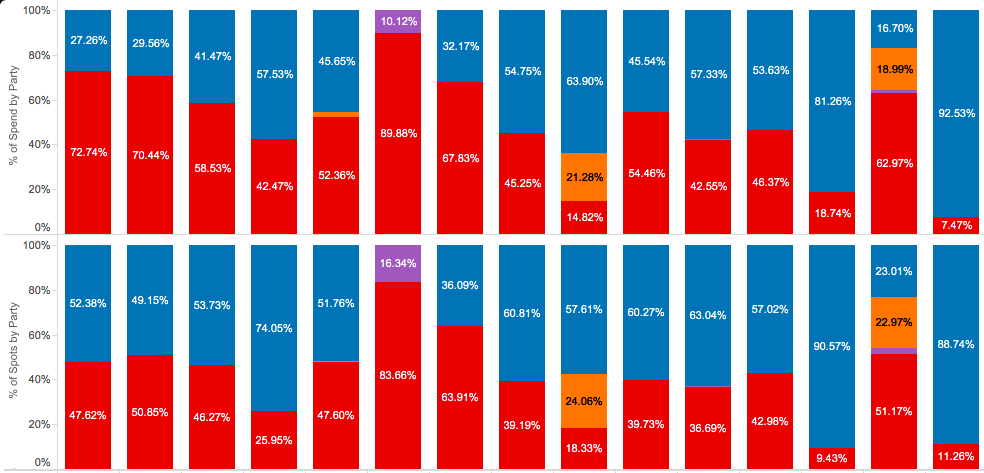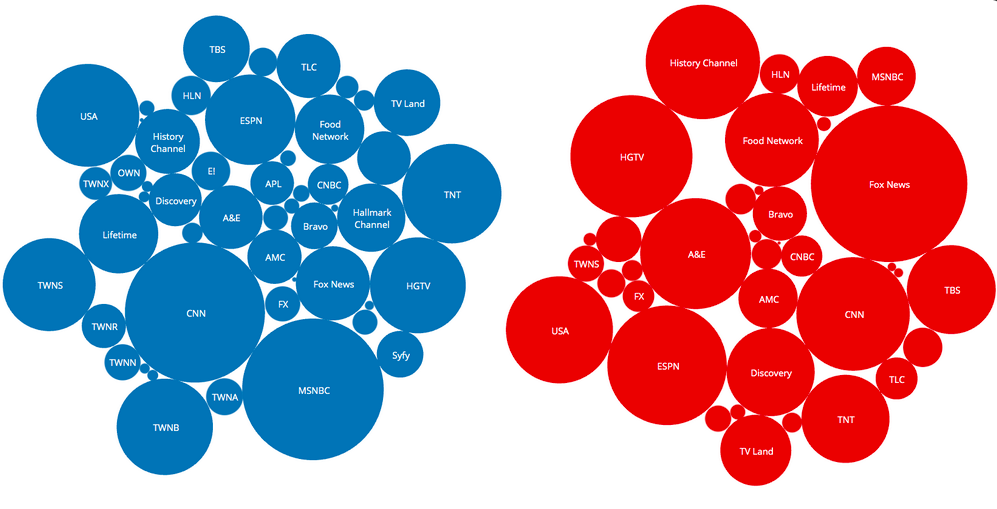Exhausted by this election season’s enormous amount of spending on television and other advertising, the viewing public is no doubt looking forward to November when (except for states with runoffs – looking at you Louisiana and Georgia) the networks will go back to airing beer commercials and made-for-TV movie promos.
However, before the sweet relief of post-election television, viewers are looking at another 16 days of last ditch attempts to win over the fraction of undecided voters who don’t get up and go to the bathroom during commercial breaks.
Related: Here’s How the GOP Could Win Control of the Senate
D.C.-based Echelon Insights, a consulting firm, has mined the Federal Communications Commission’s public filings of campaign media buys and produced a series of graphic representations of what the state of play is when it comes to the final media push of campaign 2014.
Patrick Ruffini, the conservative blogger-turned Republican strategist is one of the co-founders of Echelon, which he describes as “a technology-driven research and analytics company.” The company, Ruffini said, monitors the ad spending “as part of our overall tracking of campaigns and the issue environment.”
What the Echelon data shows is that some campaigns have run out of gas, while others have conserved their ad dollars so they can stomp on the accelerator during the final weeks of the campaign.
First, here’s a look at how ad spending on Senate races has broken down, both in terms of dollars and in the number of ad spots purchased by the Senate campaigns in some of the battleground states.
Related: Fake Football Scandal Changes the Game in Colorado Senate Race
Senate Race Media Spending in the Last Three Weeks
This chart shows the percentage of total ad dollars spent by each party with a candidate competing in a close Senate race over the past three weeks, as well as the percentage of total ad spots each side secured. (Republicans in red, Democrats in Blue, Independents in Purple.) It goes a long way toward explaining some of the recent movement in various races.
In Kansas, for example, where incumbent Republican Sen. Pat Roberts has closed the gap with Independent challenger Greg Orman, the chart shows that Roberts outspent Orman by nearly half over the period being measured. Likewise in Georgia, where Democrat Michelle Nunn has drawn ahead of Republican David Perdue, the chart shows Nunn with a nearly 50 percent advantage in the number of ad spots controlled.
Related: Can Kay Hagan Beat the One-Term Curse in North Carolina?
What Lies Ahead
This second chart shows money committed and advertising slots reserved for the remaining days of the campaign (as of October 17.) The numbers suggest that Republican Ed Gillespie has all but given up on his effort to unseat incumbent Virginia Democrat Mark Warner, and that Republican Monica Wehby is pretty much done in Oregon.
In Kansas, though, it shows Roberts very well positioned for the final weeks of the campaign, with a massive advantage over Orman in both money and ad spots. In Georgia, which was originally not expected to be a competitive race, Nunn appears to have a significant advantage as well, with nearly three times as much ad space reserved as Perdue. In Louisiana and North Carolina, embattled Democrats Mary Landrieu and Kay Hagan have both established large advertising advantages for the final weeks.
Related: 11 Incumbent Governors in the Hot Seat This Fall
Just for Fun
While the Senate is getting most of the attention, every House seat is up for election and so are dozens of governorships. For the House and Governors races, Echelon broke down the spending by cable network, resulting in the follow two charts.
The first, tracking House race ad spending, shows the Democrats to be much more diverse in their spending. While CNN and MSNBC and a handful of other channels get a significant share of the spend, the Democrats seem to spread their money pretty widely. The GOP is a good deal more concentrated, with Fox News, not surprisingly, getting the largest share of ad dollars, followed by CNN, ESPN, and the History Channel.
The dispersal of cable television ad dollars is similar for governors races, with Democrats once again casting a relatively wide net, and the GOP remaining more focused on a smaller number of large ad buys.
The dispersal of spending by both parties also shows that, one way or the other, if you turn on your television in the next three weeks, political ads will be hard to escape. But take heart, America. Less than three weeks to go.
Top Reads from The Fiscal Times:






